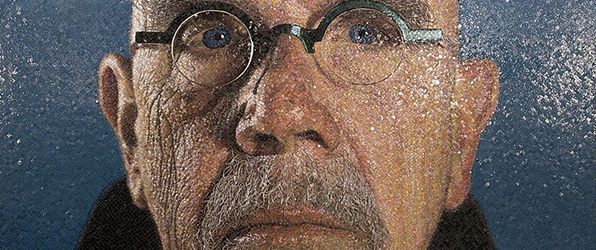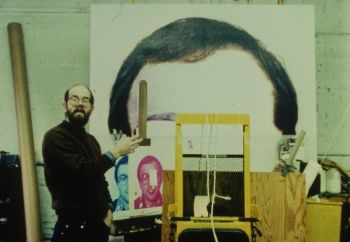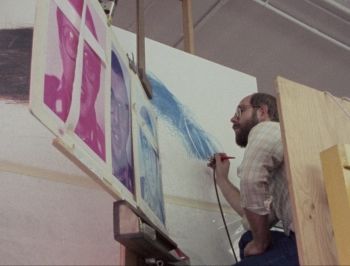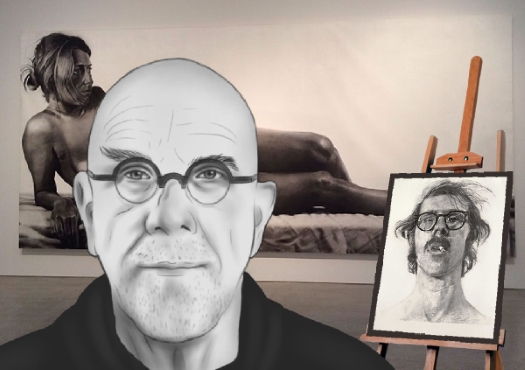Summary of Chuck Close
Chuck Close is globally renowned for reinvigorating the art of portrait painting from the late 1960s to the present day, an era when photography had been challenging painting's former dominance in this area, and succeeding in steadily gaining critical appreciation as an artistic medium in its own right. Close emerged from the 1970s painting movement of Photorealism, also known as Super-Realism, but then moved well beyond its initially hyper-attentive rendering of a given subject to explore how methodical, system-driven portrait painting based on photography's underlying processes (over its superficial visual appearances) could suggest a wide range of artistic and philosophical concepts. In addition, Close's personal struggles with dyslexia and subsequently, partial paralysis, have suggested real-life parallels to his professional discipline, as though his methodical and yet also quite intuitive methods of painting are inseparable from his own daily reckoning with the body's own vulnerable, material condition.
Accomplishments
- Photorealist painting of the 1970s celebrated the glossy, mirror-like "look" of the photograph, but after achieving that ideal, Close swiftly turned to portraiture, suggesting it as a means for exploring unsettling aspects of how self identity is always a composite and highly constructed, if not ultimately conflicted fiction.
- Close's dependence on the grid as a metaphor for his analytical processes, which suggest that the "whole" is rarely more (or less) than the sum of its parts, is a conceptual equivalent for the camera's analytical, serial approach to any given subject. Every street-smart, colorful Polaroid is as much a time-based and fragmentary gesture as any more laborious stroke of the painter's brush in the cloistered studio.
- Close has worked with oil and acrylic painting, photography, mezzotint printing, and various additional media. Shifting confidently from one to the other, Close suggests that his conceptual intentions are ultimately timeless, whereas his tools or materials are infinitely interchangeable. This is partly why Close's practice of portrait painting has for over forty years remained surprisingly "contemporary," even while the larger movement of Photorealism, his earliest chosen stylistic idiom, has long receded into history.
- Close's slow, accumulative processes, which enlist numerous abstract color applications in the service of producing "realistic," or illusory portraits, most recently finds application in the art of modern tapestry via a highly illusionistic, computer-aided method of industrial weaving that Close favors for its ability to suggest the hyper-real appearance of 19th century glass photographs(daguerreotypes).
The Life of Chuck Close

Describing how, "I discovered about 150 dots is the minimum number of dots to make a specific recognizable person," Chuck Close pioneered Photorealism. "By putting little marks together," he said his monumental portraits conveyed how, "a face is a road map of someone's life."
Important Art by Chuck Close
Big Nude
"Big Nude" is the first painting completed in Close's signature grid process, and both its size and self-conscious title indicate its ambitious nature. Although the transferred image "reads" as a flat transcription of light and dark characteristic of a photograph, the painting's variegated brushstrokes reveal Big Nude to be more of a prototype for future development than a fully resolved picture. Poised precariously between a common studio exercise in figure drawing and a 1960s girlie magazine shoot, "Big Nude" also challenges the future of representational painting at a moment in history when the genre would seem to have long ago exhausted its potential for future development. Only the antiseptic whiteness of the canvas hints at a new approach to the figure that might perfectly marry an instant, unforgiving photographic record of a subject with the artist's reconsideration of its every component over months of studied, methodical transcription.
Acrylic on canvas - Collection Jon and Mary Shirley
Big Self-Portrait
The tentative air of experimentation that might be said to characterize Big Nude is nowhere apparent in Big Self-Portrait, a watershed painting that virtually showcases Close's unique method. Abandoning the full-body view, Close turned to one of the oldest traditions anywhere in art history, the self-portrait. Close had partially set out to refute the critic Clement Greenberg's claim that it was impossible for an "advanced" artist to work in portraiture. Closes's untraditional approach involved conceiving of and creating a unique kind of "mug shot," a black-and-white idiom that exacerbated the subject's blemishes and the original photographic distortion caused by the camera. The devotion to the idea of an unsparing, head-on view led him to refuse all commissions, as Close used only his own "mug" and that of close friends for his subjects.
Acrylic on canvas - Walker Art Center, Minneapolis
Kent
For Kent, Close made use of preparatory drawings for the first time to explore the three-color process, an imitation, or re-employment, of the photographic dye-transfer method. By adopting a mechanical procedure and mimicking it physically, or by hand crafting what is normally carried out by the camera, Close suggests that illusion is ultimately in the eye of the beholder, whose own optical apparatus finally "completes" the picture. Although Close literally painted the same image three times, one atop the other in separate colors, he was surprised when the work ended up taking three times as long to complete. In order to facilitate the process, Close wore cellophane filters over his eyeglasses in order to view marks in one color at a time.
Acrylic on canvas - Art Gallery of Ontario, Toronto
Keith/Mezzotint
The large format of Keith, although not nearly as large as Close's earlier portrait paintings, did not translate well to the outdated mezzotint process. Due to its gradual erosion, the plate made only ten good prints, and the surface coloring is noticeably lighter in the middle around the sitter's nose. The mezzotint printmaking process yields a soft, light-infused surface, here seen to best effect in Closes's rendering of the sitter's hair. The random effects typical of printmaking inspired Close to experiment further with various media.
Mezzotint - The Museum of Modern Art, New York
Fanny/Fingerpainting
Close's enjoyment of the physical interaction between artist and material gave him a particular affinity for working in the fingerprint method. Criticized by some as a kitschy version of an art already informed by Pop, the unsophisticated technique, so reminiscent of child's play, seems doubly appropriate for this informal, yet subtly monumental portrait of the artist's grandmother. The numerous, individual touches of oil pigment gradually creating the appearance of supple flesh lends to the painting a sense of intimacy so appropriate to the underlying relationship between artist and his chosen subject.
Oil-based acrylic on canvas - The National Gallery of Art, Washington DC
Self-Portrait
Chuck Close's work is most often associated in the popular mind with his own likeness. Although it has been chosen by the artist largely for the sake of convenience, Close's self portraits provide an interesting arena for gauging the development of his thought and work over four decades. The insouciant stare of the young man in Big Self-Portrait makes a striking counterpart to the stolid, knowing gaze of the older Close as represented in this self-portrait of 1997. Indeed, the comparison illustrates the evolution from fledgling artist to international icon. Compared to the earlier work, the 1990s Self-Portrait also shows how abstraction has come to play a more prominent role in Closes's portraits. Each of the individual units of the grid is a miniature abstract painting unto itself, comprising a panoply of colors and shapes that seem to have jumped directly to the canvas from the artist's palette.
Oil on canvas - Private Collection
Andres
In recent years, Close has extended his investigations into various media to the ancient genre of tapestry, the repetitive and episodic weaving process in many ways paralleling his own painstaking juxtaposition of various colors in much of his portraiture. Using computerized photo transfers of glass daguerreotypes (for black-and-white versions) or Polaroid snapshots, the tapestry medium is ideally suited for Close's interest in large-scale work that nonetheless depends on pinpoint-like precision. Here, a portrait of artist-colleague Andres Serrano, notorious for his irreverent Piss Christ (1987) photograph that continues to roil conservative Christians, beams triumphant from the weave, which is deftly composed of numerous threads of various colors intertwining with such precision that the human eye is virtually seduced into believing that this is a real man pressing his face to a window.
Jacquard tapestry - PaceWildenstein Gallery, New York
Biography of Chuck Close
Childhood
Charles Thomas Close was born at home to Leslie and Mildred Close, a couple with a leaning toward artistic pursuits. Leslie Close was a jack-of-all-trades with a flair for craftsmanship; he built Charles his first easel. His mother was a trained pianist but unable to pursue a musical career due to financial constraints. Determined to provide her son with opportunities she herself never enjoyed, Mildred pushed Charles to take up a myriad of extracurricular activities during his school years and hired a local tutor to give him private art lessons.
Charles had a difficult time with academics due to dyslexia, although teachers were often impressed with his creative approach to projects. He was also diagnosed at a young age with facial blindness and a neuromuscular condition that prevented him from engaging in athletics, making the social aspects of school life difficult. Once in college, and upon deciding to make a career in art, he excelled.
Early Training
Close received a scholarship to attend the Yale Summer School of Music and Art after his junior year at the University of Washington in Seattle, which facilitated his subsequent acceptance to the Yale MFA program in 1962. The challenging environment at Yale put him in competition with a host of talented peers, such as Nancy Graves, Brice Marden and Robert Mangold. Jack Tworkov, the new director of the MFA program, supported the teaching of contemporary art movements (e.g. Pop art and Minimalism) in addition to the standard focus on Abstract Expressionism; the revised curriculum indeed proved to be a major influence on Close's later work. While at Yale, Close served as a studio assistant to printmaker Gabor Petardi. In his senior year, Close won a Fulbright scholarship, providing him with the opportunity to study art in Europe.
In 1965, after completing his travels abroad, Close began teaching classes at the University of Massachusetts in Amherst. Deciding that his own Abstract Expressionist style of painting had grown stagnant, he began to experiment with alternative forms and materials. One of his more ambitious ideas of the time involved painting a large nude from a series of photographs, but he set the project aside due to unresolved problems with color and texture. In January 1967, the college held a solo exhibition of other Pop-inspired works by Close, sparking an outrage from the administration due to his use of full-frontal nude male images. The American Civil Liberties Union defended Close in the resulting lawsuit, brought on by the university president, John Lederle. Ultimately, the ruling was in favor of the university, a decision that effectively ended his time in Amherst.
Taking a new teaching job at the School of Visual Arts in New York City that fall, Close moved to Manhattan, where he reunited with Leslie Rose, a former student. The two subsequently married that December. Close's search for a signature style was a persistent frustration to him, and with Rose's support, he continued to experiment with different styles drawn from contemporary art. In particular, Process art was highly popular at the moment, due to the rising fame of Sol LeWitt and others. Returning to the large photographic-based nude he had begun in Amherst, Close decided to approach the problem from a methodical angle. Working again from photographs, he parsed the image into a grid, which he then transferred onto a nine-foot-long canvas. Painstakingly hand-copying the photograph's gridded segments onto each corresponding cube of the canvas, Close built a larger-than-life, black and white copy of the female nude's image. The resulting Big Nude (1967), reads as both an abstract and a figurative painting. In addition, depending on the viewing distance, the painting reads as a traditional figure drawing, or as an abstract landscape of a close up, yet barely recognizable subject.
Mature Period

Close's career gained momentum from the sale of a similarly conceived Big Self-Portrait (1967-68) to the Walker Art Museum in 1969, which prompted other sales shortly thereafter. Motivated by the newly-developed method of painting, he sought to refine his technique in his first "Heads" series. Also in black and white, these paintings emphasized their photographic roots. Close used the large-scale format to exaggerate the more unflattering interpretations of the camera, creating close-up views that he describes as mug shots. In December 1969, the Whitney Museum of American Art acquired a Close portrait of composer Philip Glass, and the museum also included one of the artist's works in the Whitney Annual. Earlier in the year, Close had joined Bykert Gallery, where he participated in his first New York City group exhibition with Lynda Benglis, David Paul, and Richard van Buren. Prior to the opening of the show, writer Cindy Nemser conducted an interview with Close for the January 1970 issue of Artforum magazine, which accidentally published his name as "Chuck Close." The artist subsequently adopted it as a professional moniker from that time to the present.

Searching for a way to reintroduce color to his work, Close returned to photography for inspiration. Imitating the photographic dye-transfer process, Close developed a method that utilized separate layers of cyan, magenta and yellow. Painted on top of each other, the colors compel the eye of the observer to mix them in order to arrive at a realistic, full-color image. The first portrait executed by this method was Kent (1970-71), which took Close almost a full year to complete. He spent the next several years working on three-color-process portraits, during which his first child, Georgia, was born.
In the summer of 1972, Parasol Press invited Close to produce a series of prints by any method he desired. Intrigued, Close chose the mezzotint, a virtually abandoned printmaking technique common to 18th-century portrait reproductions. Reproducing an already gridded photograph of Keith Hollingworth, the print unintentionally revealed the schematic checkerboard pattern. These unexpected results led to a Close repeated use of the same photographs for paintings executed via different techniques and in various media. Some of the more unorthodox methods he employed included fingerprinting, the use of pulp paper, and resourcing instant Polaroid, "snapshot" photographs.
Current Work
Close's current method of painting originated with his pastel portraits of 1981. These portraits are derived by Closes's juxtaposing of different colors within each cube of the grid, a process critic Christopher Finch has colorfully referred to as a "pimiento-stuffed olive." The loose handling of color and richness of the pastels resulted in a lush, tactile surface, which Close maintains in his more recent work. Through more complex combinations of color and mark-making, Close's style of portraiture has also grown closer to abstraction, which makes its integrity to certain aspects of the photographic medium all the more notable.
In December 1988, Close suffered from intense chest pains that led to complete paralysis below the neck, a watershed moment in his life that the artist refers to as "the Event." With the dedication of his wife, who insisted that his physical therapy focus on the act of painting, Close was able to regain enough movement and control in his upper body to allow him to continue working. Steadily strengthening his arms, he completed Alex II (1989) during his rehabilitation period. The painting is much smaller than Close's previous works (Alex II is only 36 x 30 inches), and it conveys a sadness that the artist describes as representative of his conflicted mindset at the time. It exhibits, however, no loss of technique. Close has since built a studio to accommodate his wheelchair and a two-storey, remote-control easel, where he continues to dynamically develop his artistic processes with the help of studio assistants. Now, in his early 70s, and continuing to evolve in his artistic practices, Close has been applying his methods to the production of highly illusionistic imagery in the format of portraits of his friends, colleagues, and others.
Utilizing the modern computer-aided methods of tapestry, in final years of his life Close was able to approximate, in woven images, the mirror-like illusionism characteristic of the 19th century photographic glass daguerreotype (of Louis Daguerre fame). As if coming full circle, Close may be said to have reinvigorated the genre of Photorealism just when everyone had assumed it had been relegated to history. Close died of heart failure at the age of 81.
The Legacy of Chuck Close
Coming of age at a moment when Abstract Expressionism was still a major force in the art world and, for some, a rather inhibiting one, Close suggested that a return to a former category of painting, or realistic portraiture, could be a viable route for an artist's development. Close married this premise to his early fascination for photographic realism, focusing on the sequential and time-based process of transferring a photographic image to canvas as the conceptual premise for suggesting the construction of self identity, or the "persona," as a highly tentative undertaking, indeed despite its apparently seamless outcome. This conceptual foundation of Close's work has been his essential legacy to his many admirers and successors. The genre of portraiture itself, as well as the gridded, sequential conceptual artwork, have since the 1970s taken a very active role in avant-garde circles. The mix of the photographic sequence and its painterly reconstruction is seen early on, for instance, in the late 1970s work of Jennifer Bartlett, and it resurfaces time and again in the work of more portrait-based photographers of the 1980s, such as Cindy Sherman, Annie Leibovitz, Cass Bird, Nan Goldin, Kiki Smith, Andres Serrano, and Robert Mapplethorpe.
Influences and Connections

-
![Alex Katz]() Alex Katz
Alex Katz ![Philip Glass]() Philip Glass
Philip Glass
![Ross Bleckner]() Ross Bleckner
Ross Bleckner
![Philip Glass]() Philip Glass
Philip Glass![Christopher Finch]() Christopher Finch
Christopher Finch
 Ask The Art Story AI
Ask The Art Story AI
























